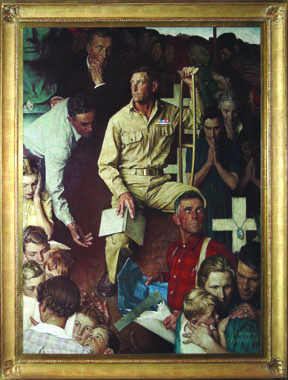“The Long Shadow of Lincoln”
Painting
Norman Rockwell (1894-1978)
Oil on Canvas
Gift of Norman Rockwell

With World War II coming to an end, Curtis Publishing Company, publishers of the Saturday Evening Post, took the occasion of Abraham Lincoln’s birthday in February, 1945 to ponder the peace about to fall over the world’s warring nations and the uncertain future. As the instruments of this message, they chose America’s foremost poet, Carl Sandburg, and paramount artist, Norman Rockwell.
Sandburg responded first with an eighty-three stanza litany entitled “The Long Shadow of Lincoln,” which was inspired by several lines from President Lincoln’s December 1862 message to Congress. The work is considered one of his finest efforts.
Rockwell used as his inspiration the publisher’s theme, “Thoughts on Peace on Lincoln’s Birthday,” along with Sandburg’s poem and Lincoln’s Second Inaugural Address (“With malice toward none and charity for all…”).
The painting, alternately titled “The Long Shadow of Lincoln” and “Thoughts on Peace on Lincoln’s Birthday,” is almost unique among Rockwell’s works in that the amount of symbolism present in the piece is uncharacteristic for this quintessential American master.
The central focus of the painting is a disabled soldier, newly returned from the battlefield, who is contemplating the challenges of the postwar world. He has sought inspiration in the words of Abraham Lincoln, as exemplified by the open book on his knee. Meant to be Life of Lincoln, a popular biography by Ida Tarbell, Rockwell later claimed he left the title off the book because he disliked using printed letters in his illustrations. The soldier gazes almost wistfully towards the bust of Abraham Lincoln in the upper left corner.
Around the perimeter of the painting, surrounding the solider, are allegorical representations of the blessings of liberty for which Americans were fighting. In the upper right hand corner of the canvas, the displaced masses of the world are streaming towards the bust of Lincoln, the man who stood for liberty in a land where all people, regardless of race or creed, are created equal.
Situated on the right hand side of the work is a group of women in prayer, symbolizing freedom of worship, an inalienable right guaranteed by the United States Constitution.
The crosses, dogtags and helmet represent the ultimate sacrifice made by our nation’s fighting men. They remind us that the blessings of liberty that we enjoy do not come without a price. In the bottom right corner, the mother, father and child indicate the importance of the family unit. At the bottom of the painting Rockwell has included two black hands, reaching up to clasp the white man’s hand in a symbol of racial brotherhood. The fact that the black man is not in the picture indicates Rockwell’s conviction that further efforts were necessary to achieve the goal of racial equality. On the left, children surround a teacher who is reading a book, representing the importance of universal education.
Perhaps the most important symbol is in the center of the work. The wounded soldier’s amputated left leg is obscured by the builder with his blueprints, demonstrating Rockwell’s belief that the sacrifice of World War II was not in vein, and that a better, stronger world would be built.
After being featured in the February 10, 1945 issue of the Saturday Evening Post, the painting was donated by Rockwell to the Lincoln Memorial Shrine.
Over the years it has proven very popular with Shrine patrons. In a letter to Rockwell in 1960, Shrine Curator Katherine Hixson described the painting’s impact on visitors. She wrote, “Little children who cannot always understand the whole meaning of the Shrine, will stand and study your meaningful faces. Here are real people from the world in which they live. Scarcely a day passes without some discussion about its heartfelt symbolism.”
The Lincoln Shrine is especially proud to exhibit this work because it serves as an excellent bridge between Lincoln’s time and our own. Although Lincoln was perhaps the greatest American of the 19th Century, Rockwell’s painting reminds us that Lincoln’s ideas had relevance in the midst of the worst crisis of the twentieth century and, correspondingly, that his life and times are still worthy of study as we enter a new millennium.


